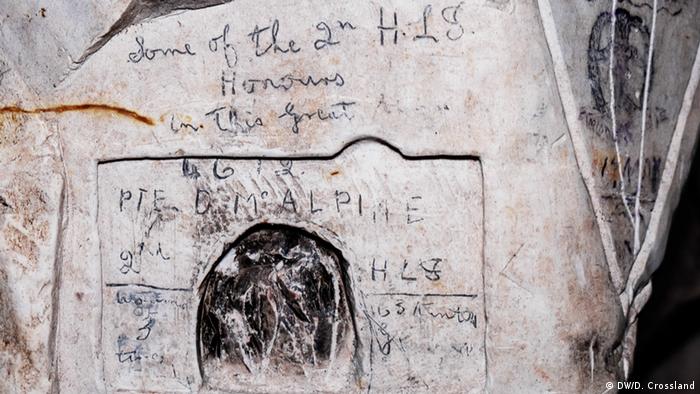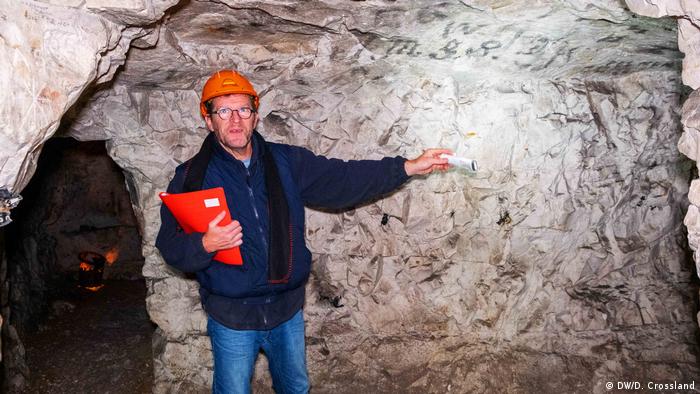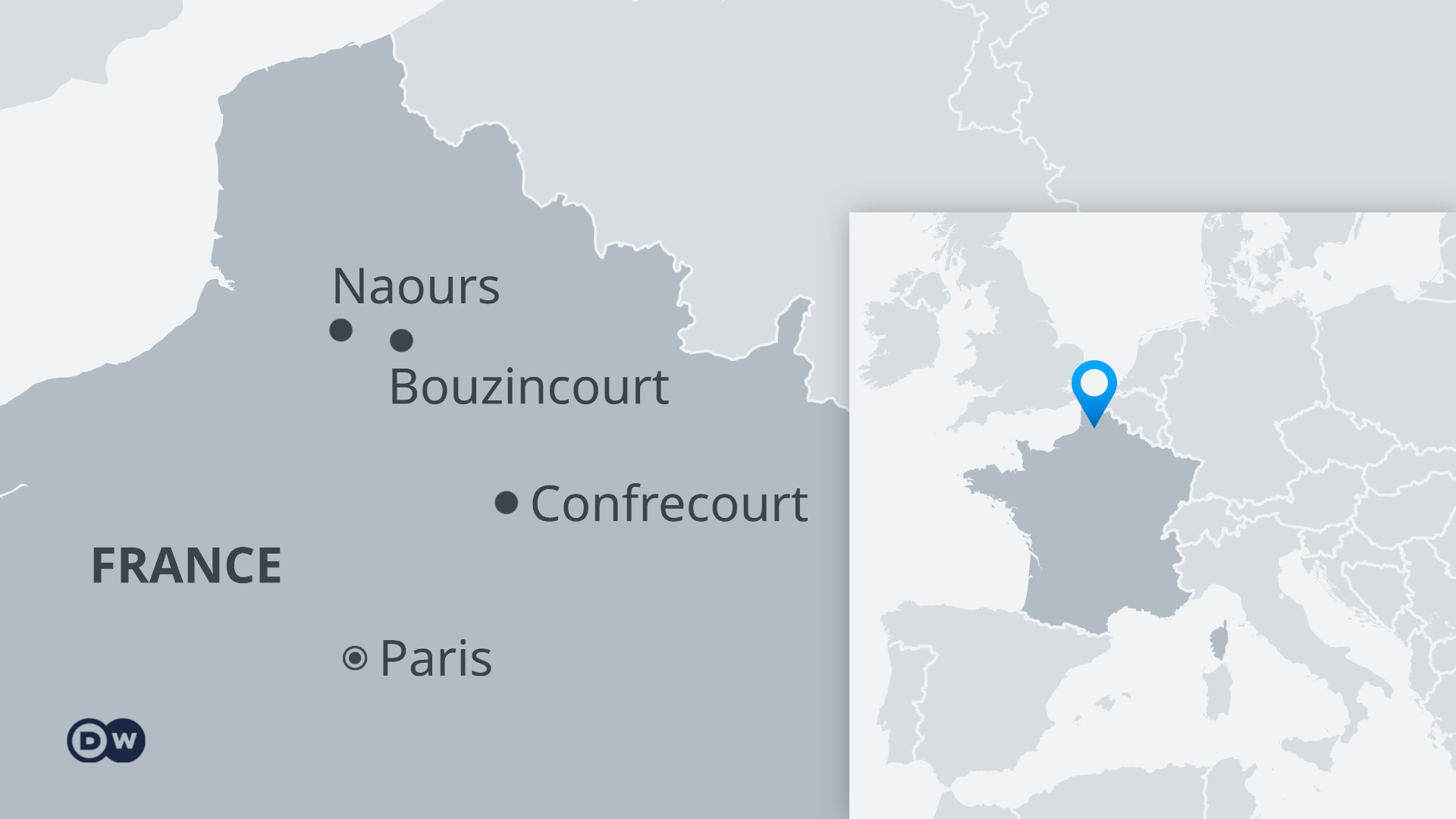World History
Related: About this forumFrance: WWI Signatures, Graffitti & Mementos of Soldiers On All Sides Extant In Caves Underground
In France, underground mementos of World War I. During the First World War, soldiers on all sides left inscriptions and carvings in caves and bunkers. A century on, there is growing interest in the graffiti that tells stories of pride, hope and longing. DW, Dec. 31, 2019.
WM Lecky visited the spectacular underground city of Naours in northeastern France in 1916 while on rest and recuperation from the fighting on the Western Front. For just a few hours, he was a tourist, strolling around the tunnels and caves of this medieval labyrinth built as a refuge from pillagers. Like thousands of Australian soldiers who came here, Lecky wrote his name on the wall, complete with his hometown in the state of Victoria, Australia.
Lecky didn't survive the war. The website of the Commonwealth War Graves Commission lists William Mervyn Lecky as having fallen on September 1, 1918. He is buried in a cemetery in Peronne, an hour's drive away. His name is among a total of 3,200 — of which 2,200 are Australian soldiers — that have been found in the tunnels of Naours.

- The rectangle was fashioned to hold a postcard, and a groove was even added for a finger to remove the card.
"They had tour guides, and shuttle buses were laid on to take the soldiers to see the tunnels," said Gilles Prilaux, a leading researcher in World War I battlefield archaeology. "The Anglo-Saxons, especially those who come from very far away, that is to say the Australians, the Canadians, the New Zealanders, the South Africans, they left their names and a lot of other in- formation like their postal address, service number and city of origin."
"Maybe it's because they thought this would be the only time they visit France. But maybe also it was because they thought, 'This may be the last time I can write my name because tomorrow may be my last day.'"
During the war, soldiers on all sides made inscriptions in tunnels, caves and bunkers. Prilaux, who works at the EPCC Somme Heritage Organization, said graffiti has been found at 400 underground sites in the Picardy and Nord-Pas-de-Calais regions alone.

- "I think the soldiers left their names here because they knew they might die," said Jean-Luc Rouvillain.
Surging interest in penciled legacy: It makes up a trove of historical information and artistry that is attracting growing interest from researchers and the descendants of the soldiers. The graffiti sheds light on the mindset of the men who had to fight in a war that became synonymous with futile sacrifice.
The writing is also enabling researchers to trace soldiers and their families, because in many cases, it is the last record of men who simply disappeared. The First World War is infamous for the hundreds of thousands who went missing because they were obliterated by shellfire or who sank into the churned-up mud of Flanders.
When Prilaux started researching the soldiers who wrote their names in Naours, he left messages on Facebook pages dedicated to battalions that fought in the war. "I asked for help in finding the families of a soldier who fought in such-and-such a battalion." The response was overwhelming. "I started receiving a hundred emails a day from families writing to find out if their ancestor had left their name at Naours. I have already met around 20 families who made the trips specifically to see inscriptions left by their Australian ancestors." "The First World War was zero hour for the Australians, a hugely important point in their history. It was the first time they and the New Zealanders formed their own army corps rather than being integrated into British units."

Inside the Bouzincourt labyrinth: In the village of Bouzincourt, a spiral staircase leads from the church into a 16th-century labyrinth of man-made caves that contains graffiti so clear it might have been written yesterday.
Researchers have found helmets, rifles, bullets and bully-beef tins left by British and Commonwealth soldiers who sheltered here from the German guns during the 1916 Battle of the Somme.
Torches pierce the blackness to reveal names, ranks and service numbers, intricate regimental insignia and portraits penciled onto the chalky rock. "We have recorded 2,100 names," said Jean-Luc Rouvillain of the Bouzincourt Heritage Society. "I think the soldiers left these messages so that one day their children or grandchildren would come and see them." That is now happening. Rouvillain said more and more descendants of soldiers have been coming to visit the caves in recent years.
There is grim humor in the declaration "Here's Joy Forever" scrawled on the wall, and regimental pride in a poem by a soldier from the Highland Light Infantry which starts with the line: "Halt the Greys, Steady the Bays and let the HLI march past." One cave was turned into a chapel with a small cross carved into the rock. Next to it, the words "Welcome Home" are written..
National differences in style: Prilaux said there were marked national differences in the types of inscriptions. The French and Germans rarely recorded their names on the walls. Some of the French inscriptions and bas-reliefs were quite beautiful, such as a spectacular bust of Marianne and an entire chapel carved into the walls in a limestone quarry at Confrecourt. German inscriptions, by contrast, tended to be more functional and were often infused with propaganda, he said. "There is a lot about national glory or just very functional signage."...
More, https://www.dw.com/en/in-france-underground-mementos-of-world-war-i/a-51811497
3Hotdogs
(13,394 posts)stationed near Cambridge. They would take cigarette lighters, light them and hold them close to the ceiling. The carbon from the flame would imprint on the ceiling. There were thoughts of painting over them after the war was over and the Yanks went home. Instead, it was decided to leave it alone.
appalachiablue
(42,906 posts)of US soldiers there in WWII, or the Cambridge American Cemetery 4 miles from town. Next time.
https://en.wikipedia.org/wiki/Cambridge_American_Cemetery_and_Memorial